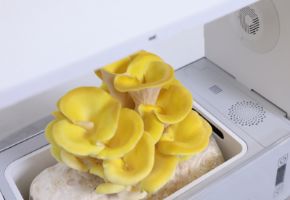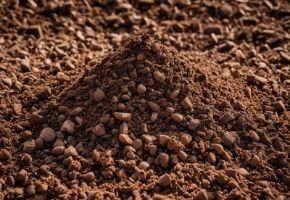Pleurotus Citrinopileatus substrate
The Pleurotus Citrinopileatus – Golden Oyster Substrate allows you to easily grow mushrooms inside the Grow Box. Simply make a few cuts on the packaging and place the block inside the machine. It's the ideal product for beginners, requiring no complex sterilization or mixing of mycelium and culture medium. Let's discover its features together!
Basic information
Class: Basidiomycetes
Scientific Name: Pleurotus ostreatus
Common Names: Gelone – Golden Agaric – Golden Mushroom - Citrine Mushroom – Golden Mushroom – Yellow Oyster – Lemon Mushroom
Characteristics
Cap: 5-15 cm, fleshy, eccentric, cone-shaped, color varies from intense yellow to lemon yellow.
Gills: dense and decurrent, yellow/lemon yellow.
Stem: thin, firm, long, eccentric, yellow.
Flesh: yellow, somewhat tough, faint odor, and characteristic taste.
Spore: violet-gray in mass. Depending on its values, the color of the mushroom caps varies from light lemon to rich yellow. Pleurotus citrinopileatus is the perfect choice for those new to mushroom cultivation. It grows at room temperature and wherever it's warmer.
Natural habitat
It is a saprophytic-parasitic fungus, with a specific habitat of hardwood trees like oaks, elms, and beeches. The fruits grow in clusters of small funnel-shaped caps of bright yellow color. The mushroom is native to the subtropical regions of Asia.
Normally, it fruits in the summer season: now with the grow-box, you can extend the maturation period, harvesting throughout the year by keeping the lamps on to best heat the environment!
Cultivation requirements
Temperature: 28-35°C for mycelium growth, 30-35°C for fruiting
Humidity: 90-95% during colonization, 80-85% during fruiting
Tips
- Growth stages: most mushrooms have two main growth stages: substrate colonization by the mycelium and fruiting (production of fruiting bodies). These stages often require slightly different conditions.
- Ventilation: besides temperature and humidity, proper ventilation is crucial, especially during the fruiting stage. It helps prevent the formation of unwanted molds and bacteria and stimulates the formation of fruiting bodies.
- Substrate: the type and quality of the substrate significantly influence growth. Each species has specific substrate preferences.
- Light: although mushrooms do not photosynthesize, many species require a certain amount of light to stimulate fruiting and determine growth direction, which is where the Grow Box with its lighting bodies becomes useful for cultivation!
- pH: the pH of the substrate is another important factor. Most mushrooms prefer a slightly acidic environment, with a pH between 5.5 and 6.5. In the case of a ready-to-use substrate like this, it's not an element you need to worry about as the product is already mixed and inoculated!
- Thermal shock: thermal shock can create problems in mycelium propagation or fruiting, generating molds and contaminants in the substrate, on primordia, or on the mushrooms themselves. Only some species, like Shiitake, benefit from a thermal shock (temporary exposure to lower temperatures) to stimulate fruiting.
- Humidity cycles: some growers practice humidity cycles, alternating periods of high humidity with periods of slight drying, to stimulate the production of fruiting bodies. In this case, it will be sufficient to monitor the tray and the display. If the temperature rises excessively and humidity drops below a certain threshold, it is temporarily recommended to turn off the lights.
- Contaminations: controlling temperature and humidity is also crucial to prevent the growth of contaminating organisms like molds and bacteria. If yellow spots or yellow liquid appear on the substrate, it means the mushroom has come into contact with a contaminant and is reacting by producing an antibiotic substance (the liquid). 9. Adaptation: fungal species can slightly adapt to conditions different from optimal ones, but this can affect the yield and quality of the fruiting bodies.
- Constant monitoring: given the sensitivity of mushrooms to environmental conditions, constant and precise monitoring of temperature and humidity throughout the growth cycle is essential. Since the grow box is not only a cultivation tool but also a piece of furniture, you can always keep your mushrooms under surveillance comfortably in your living room!
Organoleptic properties
It attracts attention with the unusually bright coloration of the caps and the refined conical shape of the fruiting bodies. Its taste is the same as Pink Oyster mushrooms (Pleurotus djamor), but with a bright yellow hue. These mushrooms can be bitter when raw or undercooked but take on a nutty flavor when thoroughly cooked. The flavor improves with careful cooking. Its peculiarity is resistance to increased air temperature.
Nutritional properties
Pleurotus are among the most cultivated mushrooms in the world, after button mushrooms and shiitake, and among the most appreciated. They have a high protein content (some species up to 35%), high digestibility, and high fiber and mineral content, including potassium. Clinical studies on Pleurotus are not abundant, but some suggest effects of reducing cholesterol and blood sugar.
The beta-glucan fraction contained in these mushrooms, once extracted, has anti-allergic, anti-inflammatory, and immunomodulatory effects.









